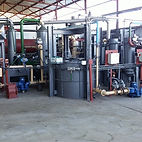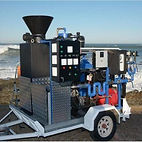
Recor offers green technologies/solutions converting waste into electricity, fuel, food and water on any scale.
TECHNOLOGIES
This technology is ideal for onsite applications at factories or for small to medium municipalities. The pyroliser can convert most carbon based waste types into gas and from there electricity, heat, steam and even fuels.
The technology is highly efficient (80-90%) and is profitable; with on average less than 4 years return on investment. The system will last for 25 years plus and is a must for any industry producing waste and requiring energy.
This pyrolysis technology is optimised for converting tyres into tyre pyrolysis oil and diesel can be produced with an added hydrogenator. The kiln runs at lower temperatures in an oxygen starved environment, is continuous feed and has very low emissions.
The Plastics to Diesel plant is optimised for plastic depolymerisation. Plastics are cracked in a zero oxygen environment and distilled into liquid fuels of which diesel is the main fraction.

Pyrolysis Optimised to Convert Waste Oil into Diesel
The Waste Oil to Diesel plant makes use of state-of-the-art purification and regeneration technology which rapidly separates contaminants from waste oil, thereby recovering either diesel or base oil which meets national standards. The design makes use of energy saving technology and a world-class decolourisation system.
Waste Oil to Diesel
The Biomass Gasifiers are cost effective solutions for single stream organic waste types. The gasifiers can be mobile, and innovative applications, such as converting human waste into electricity, have proven to be a highly required solution. The gasifier has low emissions due to a limited combustion environment.
This new compressed air power storage is a recently developed battery that lasts for over 30 years and uses only electrical and mechanical components. Air is compressed at 200 bar and released to drive a hydraulic motor; which in turn drives an alternator.
Due to the high demand of water and the synergy between power and water, we have introduced atmospheric water generators as part of our rang of solutions. This enables us to generate power and water in highly polluted or remote areas.
These generators produce water from air with a minimum of 35% humidity. It is an excellent solution for islands, mines and remote communities. The potable water very clean and the system is highly mobile.

Waste Processing Equipment
We offer turn key material recovery facilities (MRF's) that are simplified and low cost for emerging markets. Our pre-processing equipment are particularly suited for these markets, where job creation is important and the MRF needs to be small. This is so that it can process waste on a small scale in order to accommodate industry and smaller municipalities that do not require large automated MRF's.
Shredders, Granulators, Conveyors, Balers, Wrappers, Briquetting Systems, Pelletisers.
MORE INFORMATION ON THE TECHNOLOGIES ABOVE
Pyrolysis.
Pyrolysis is a thermochemical decomposition of organic material at elevated temperatures in the absence of oxygen (or any halogen). It involves the simultaneous change of chemical composition and physical phase, and is irreversible. The word is coined from the Greek-derived elements pyro "fire" and lysis "separating".
Pyrolysis is a type of thermolysis, and is most commonly observed in organic materials exposed to high temperatures. It is one of the processes involved in charring wood, starting at 200–300 °C (390–570 °F).[1] It also occurs in fires where solid fuels are burning or when vegetation comes into contact with lava in volcanic eruptions. In general, pyrolysis of organic substances produces gas and liquid products and leaves a solid residue richer in carbon content, char. Extreme pyrolysis, which leaves mostly carbon as the residue, is called carbonization.
The process is used heavily in the chemical industry, for example, to produce charcoal, activated carbon, methanol, and other chemicals from wood, to convert ethylene dichloride into vinyl chloride to make PVC, to produce coke from coal, to convert biomass into syngas and biochar, to turn waste plastics back into usable oil, or waste into safely disposable substances, and for transforming medium-weight hydrocarbons from oil into lighter ones like gasoline. These specialized uses of pyrolysis may be called various names, such as dry distillation, destructive distillation, or cracking. Pyrolysis is also used in the creation of nanoparticles, zirconia and oxides utilizing an ultrasonic nozzle in a process called ultrasonic spray pyrolysis (USP).
Pyrolysis also plays an important role in several cooking procedures, such as baking, frying, grilling, and caramelizing. Besides, it is a tool of chemical analysis, for example, in mass spectrometry and in carbon-14 dating. Indeed, many important chemical substances, such as phosphorus and sulfuric acid, were first obtained by this process. Pyrolysis has been assumed to take place during catagenesis, the conversion of buried organic matter to fossil fuels. It is also the basis of pyrography. In their embalming process, the ancient Egyptians used a mixture of substances, including methanol, which they obtained from the pyrolysis of wood.
Pyrolysis differs from other processes like combustion and hydrolysis in that it usually does not involve reactions with oxygen, water, or any other reagents. In practice, it is not possible to achieve a completely oxygen-free atmosphere. Because some oxygen is present in any pyrolysis system, a small amount of oxidation occurs.
The term has also been applied to the decomposition of organic material in the presence of superheated water or steam (hydrous pyrolysis), for example, in the steam cracking of oil.
We use gas phase pyrolysis form 10kw to 1000kw for small applications at municipalities and at industrial premises for onsite waste to energy conversion. Flash Pyrolysis modular units starts from 5kw and used together with autoclaves for unsorted MSW to energy conversion.
Steam Reforming.
Steam reforming is a method for producing hydrogen, carbon monoxide, or other useful products from hydrocarbon fuels such as natural gas. This is achieved in a processing device called a reformer which reacts steam at high temperature with the fossil fuel. The steam methane reformer is widely used in industry to make hydrogen. There is also interest in the development of much smaller units based on similar technology to produce hydrogen as a feedstock for fuel cells.
We use steam reforming as a preferred solution for large scale watste to energy projects.
Plasma Arc Furnace
DC arc furnaces were first used industrially for the reductive smelting of chromite fines to produce ferrochromium thirty years ago. Since then, they have been used for a variety of applications, including the smelting of ilmenite to produce titania slag and pig iron, the recovery of cobalt from non-ferrous smelter slags, and the smelting of nickel laterite ores to produce ferronickel. The power of these furnaces has increased from 12 MW to 72 MW for ferrochromium, and to 80 MW for ferronickel. The largest of these furnaces requires two electrodes to carry sufficient current to generate this much power. A review is presented of various DC arc furnaces in use, along with a discussion of the likely ways in which furnace power might be increased further in the future.
We use Arc furnaces in extreme applications like water treatment residue (WTR) which is basically a hazardous toxic mud derived from cleaning water.
Biodegradable organic waste can be converted into biogas and from there into electricity. We have various reference plants running and this is an ideal waste to energy solution for waste tyoes that is wet or that can easliy be digested like food waste, vegetables, piggery waste, certain agricultural waste types etc.
Waste Processing Equipment
Shredders
Our shredders are custom build and can shred tyres, municipal solid waste, medical waste, metals, plastics and we have a new custom designed shredder for OTR (Oversized Mine Tyres).
Balers
Our balers are custom built and can be operated automatically or manually and with various ties like PP rope or wire.
Wrappers
We have designed a lost cost wrapper that is manually operated and a real alternative solution to hign cost imported and automated wrappers. The system can wrap round or square bales.
Conveyor systems
Due to the demand to process waste and the lack of local solutions we have developed a simple meterial recovery system that is local
Cranes and Grabs
Custom crances and grabs can be manufactured to suit each appication.
An atmospheric water generator (AWG), is a device that extracts water from humid ambient air. Water vapor in the air is condensed by cooling the air below its dew point, exposing the air to desiccants, or pressurizing the air. Unlike a dehumidifier, an AWG is designed to render the water potable. AWGs are useful where pure drinking water is difficult or impossible to obtain, because there is almost always a small amount of water in the air that can be extracted.
We use atmospheric water generators together with our waste to energy solutions to offer our clients a true off grid solution where we can deliver stored electricity and potable water, all you need is waste.





